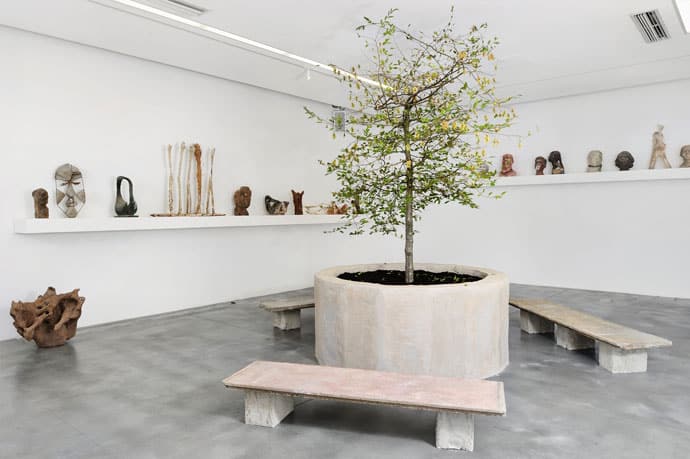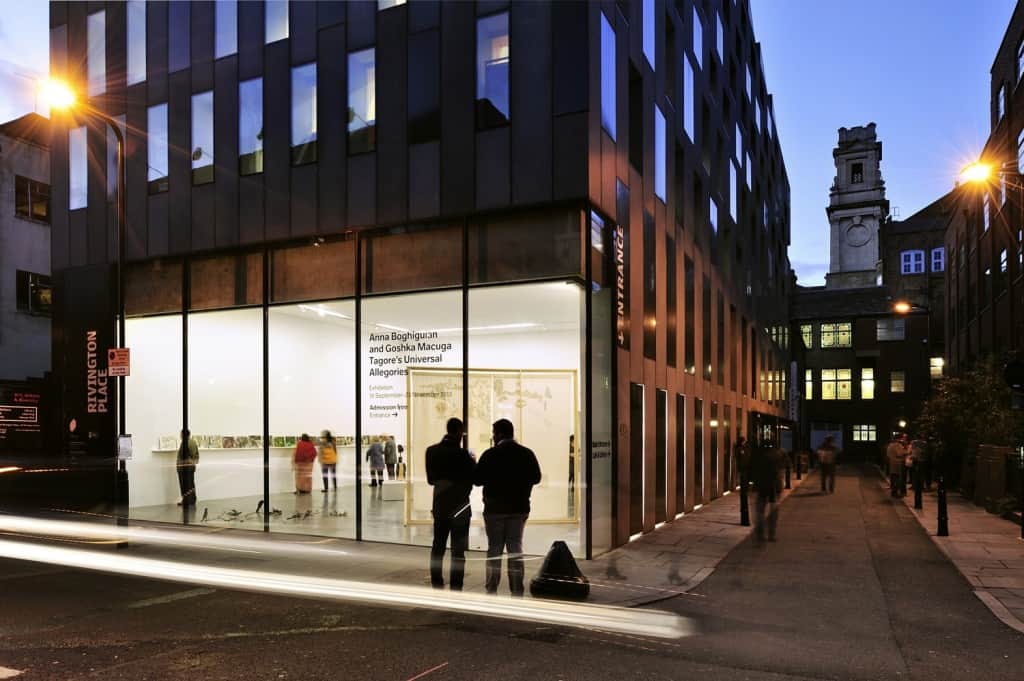Till 23 November, Iniva (Institute of International Visual Arts) in London hosted the exhibition of installations created by two artists – Goshka Macuga and Anna Boghiguian. The exhibition presented the profile and artistic activity of a prominent philosopher, poet, composer and teacher Rabindranath Tagore, who was awarded the Nobel Prize in literature for the year 1913.
The starting point for this particular exhibition by Macuga and Boghiguian is an experimental school named Visva Bharati, established by Tagore in Santiniketan in the Indian state of West Bengal. Both artists visited Santiniketan in the past. This year Boghiguian spent a few months in this school, whereas Macuga went there in 2006. The artworks presented in Iniva represent the artists’ inspirations drawn from their stay in India. Educational practices in the school established by Tagore consisted in combining applicable methods developed in India, as well as in Europe. At the beginning of the 20th century, Santiniketan was an avant-grade centre. Its philosophy was based on the principles of ecology and experimental pedagogy; it educated budding artists, craftsmen, writers, dancers and musicians. What is more, at Santiniketan, progressive thinking based on Bauhaus school was strictly interconnected with tradition and the Indian educational style, called tapovana – a forest school.

Goshka Macuga, When was Modernism? Installation view, Iniva at Rivington Place, photo: Thierry Bal, courtesy of Iniva
Tagore believed in the world without borders, “where ideas and knowledge could be freely and equally assimilated and exchanged” (Amrit Sen, “Beyond Borders”: Rabindranath Tagore’s Paintings and Visva-Bharati). He was a true citizen of the world and an erudite. He was characterized by an insatiable curiosity about the world and continuous willingness to familiarize himself with new cultures and fields of science.
Both artists who created the current exhibition seem to follow Tagore’s example. Macuga and Boghiguian are both utterly cosmopolitan, who create their own artworks in the meantime between their numerous journeys around the world. Both artists’ works belong to interdisciplinary art category and draw upon influences from various fields.
In her artistic work, Goshka Macuga simultaneously acts as an artist, an investigator, a historian and a curator. She carries out complex projects on the basis of historical, archival and scientific materials. As a part of the current project, she converted one of the exhibition rooms in Iniva into a small archival research room, where the exhibition’s visitors can familiarize themselves with souvenirs, letters, newspaper cuttings and photographs of Tagore’s family. These archival materials are closely interconnected with Macuga’s works. By combining archival materials with the present, the artist reveals new themes and introduces the visitors to new contexts. This way of presentation gives everyone an opportunity to reflect on the unknown and the forgotten.

Iniva’s Education Space – Archive Materials from the Tagore Centre UK 2013, Photo: Thierry Bal, courtesy of Iniva
In another room of the gallery, the installation entitled When was Modernism? (2008) is presented. It symbolically recreates Santiniketan school’s courtyard, where, in the fresh air, philosophical disputes and discussions of students and their mentors used to take place. The title of this installation itself is worth elaborating on. In Macuga’s works, there are frequent references to modernist tradition. This particular installation is composed of numerous smaller parts, including sculptures, artefacts and objects. The whole immaculately clean space of the gallery’s White Cube has been symmetrically organized around the circular concrete well, with the tree growing right in the middle of it. Simple benches surround the well. In the corner of the room, on makeshift mobile platforms, there are figurative sculptures and busts made of clay or stone. Attached to the wall are shelves with the rows of busts, heads and abstract forms. There are bars sticking through the sculptures, every presented work is damaged or unfinished. Macuga found all these works in Santiniketan’s courtyard itself, where arts students used to practice and develop their sculpting skills. It can be concluded that Macuga, just as former European colonists, became fascinated with oriental culture and, therefore, decided to take some of its treasures with her. Interestingly enough, the artworks collected by Macuga have universal meaning, which is a characteristic feature of modernism. The atmosphere of contemplation feels prevalent in the exhibition room – concrete is combined with nature, just as it used to be in modernist utopia. One can feel the coexistence of Bauhausian order, oriental tranquillity and meditation.

Goshka Macuga, When was Modernism? (detail), installation view at Rivington Place, 2008, mixed media, photo: Thierry Bal, courtesy of Iniva
By means of this installation, Macuga aims to attract our attention to Tagore’s legacy, which contributed to the development of art education system in India.
In the 1920s, the school in Santiniketan started international cooperation. For example, in 1922 a group exhibition of the most talented Indian artists and Bauhaus masters was organized in Calcutta. Paul Klee, Lyonel Feininger, Johannes Itten and Wassily Kandinsky sent their works to be presented there. This exhibition showcased works of Indian artists as well as some of the most famous international artists from the Bauhaus school and it successfully proved the equality of both art movements. It is worth noting that colonialism was thriving at that time, so intercontinental cooperation and intercultural dialogue were virtually nonexistent. In 1921, the Santiniketan school was awarded a university status and named Visva Bharati. The university exists nowadays and continually develops the tradition of artists’ residency programmes.
Tagore aimed to combine local culture with cosmopolitan openness to different viewpoints. The motto of Visva Bharati University: “Where the world makes its home in a single nest”, perfectly renders this principle. Acting as culture archeologist, Macuga seems to strive to achieve the similar goal. She presents local stories in a much broader cultural and historical context. She manages to successfully include “big narratives“ in a very limited space of a gallery room.
Iniva (Institute of International Visual Arts) officially opened to the public in 1994, creates exhibitions, publications, multimedia, education and research projects. Iniva engages with new ideas and emerging debates in the contemporary visual arts which reflect the diversity of contemporary society. It is located at Rivington Place in east London. During the course of its 19-year existence, Iniva has hosted and/or produced major solo exhibitions by significant British and international artists, including sculptor Hew Locke (‘Kingdom of the Blind’, in 2008), filmmaker Zineb Sedira (‘Currents of Time’ in 2009), Donald Rodney(‘In Retrospect’, in 2008), Keith Piper (‘Relocating the Remains’ in 1997), Yinka Shonibare (‘Diary of a Victorian Dandy’ in 1998).








